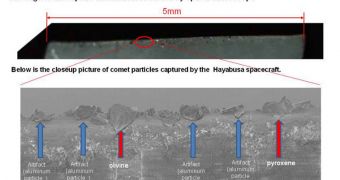Experts with the Japanese Aerospace Explorations Agency (JAXA) announce that the Hayabusa sample-return mission did return artifacts from its trip to near-Earth asteroid 25143 Itokawa.
The spacecraft returned to Earth on June 13, 2010, and landed in the Australian Outback. It spent 7 years flying through space, and at many points in the mission controllers feared that the probe will not make it home.
Its engines suffered many glitches, and were all damaged in one way or the other. Demonstrating excellent training, Japanese flight controllers managed to keep it on course, and to return it to Earth.
But a great deal of uncertainty remained over whether the spacecraft had actually returned anything from Itokawa. Many believed that the sample chamber ready would be empty upon return.
This certainly appeared to be the case a few months ago, when the container was first opened. But JAXA scientists now confirm that the chamber indeed contains particles of extraterrestrial origin.
A total of about 1,500 grains were identified as originating from rocks, and are now believed to have been collected from the asteroid. Most of them are less than 10 micrometers in diameter.
Not even JAXA has the necessary technology to handle and prepare these particles for extensive testing, and so engineers with the agency are currently working to developing these methods.
The opened container is currently located at a JAXA sample curatorial facility in Sagamihara, Japan, and is being investigated by astromaterials scientists from the Asian nation, NASA and Australia.
The same team was responsible for the preliminary cataloging and analysis of the contents that were initially discovered inside the sample chamber, Space Fellowship reports.
In addition to returning samples to Earth, Hayabusa also played a very important role in acting as a technological testbed for a variety of systems that NASA and JAXA wanted to test.
These technologies, which include electrical propulsion and autonomous navigation, will most likely be used in upcoming sample-return missions to near-Earth objects (NEO), or potentially to more distant targets, such as Mars.
Hayabusa was the second spacecraft ever to touch down on the surface of a NEO (in 2005), following the successful rendezvous of the NASA’s Near Earth Asteroid Rendezvous-Shoemaker spacecraft with the asteroid Eros on February 12, 2001.

 14 DAY TRIAL //
14 DAY TRIAL //